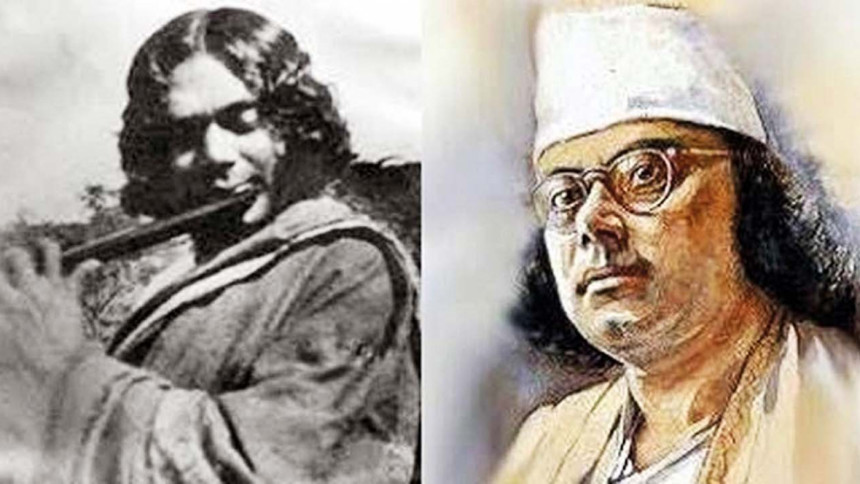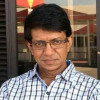Kazi Nazrul Islam and Our Struggle for Emancipation

I am a poet of the present, and not a prophet of the future. […] My birth in this country and this society does not mean that I shall remain constricted and confined to them. No, I belong to all countries and to the entirety of humanity.
—Kazi Nazrul Islam
1
No poet in the history of Bangla literature—with the exception of Rabindranath Tagore—can simply match up to the staggering range of Kazi Nazrul Islam's preoccupations and pursuits. A poet and a musician in the first place, Kazi Nazrul Islam (1899—1976) was also a music director, music teacher, short-story-writer, novelist, playwright, essayist, a creative "theorist" in his own right, film-maker, editor, journalist, drummer, even an actor. And Nazrul was a spectacularly vibrant activist. He was a member of the working committee of a political party. Once he had even gone to the extent of running in an election—even if unsuccessfully—for a seat in the Indian Legislative Assembly.
In fact, one can place Nazrul's work in the global tradition of what the French philosopher Jean-Paul Sartre once called littérature engage—the tradition of socially committed, politically engaged, radically interventionist literary productions. I've argued elsewhere that Nazrul is more than a 'rebel poet;' that, more appropriately, and by his own admissions, Nazrul is a revolutionary poet. I've also argued that in the interest of decolonizing comparative literature as well as our own mind, Nazrul can profitably be situated in the constellation of a whole host of anticapitalist and anticolonial poets from Asia, Africa, and Latin America—ones who poetically and powerfully mediated and mobilized the cause of revolutionary politics without degenerating into vulgar didacticism.
It is not for nothing that not only one or two but six of Nazrul books of poetry and prose were banned by the British colonial government in India—an unprecedented event in the history of the world—and that Nazrul himself had to go to prison. But prison itself could by no means imprison his voice. While in prison, Nazrul simultaneously wrote and sang in his head, penned his remarkable "Rajbondeer Jabanbondee," and even staged one of the fiercest hunger strikes in the history of the world. Given the very mode of his being and the uniquely resistant rhythm of his body in the otherwise subjugating site of the colonial prison, I think Nazrul appears to be a matchless figure in the history of world poetry—a figure that remains relevant to the question of resistance anywhere in the world.
2
But Nazrul's fierce resistance, revolutionary voice, phenomenal productivity, and the variety of his preoccupations spanned a relatively brief period of twenty-four years between the two World Wars—from 1919 to 1942. And of those twenty-four years, Nazrul gave only twelve to poetry, and later increasingly moved on
to the world of music, inaugurating—one might argue—an excitingly experimental chapter in the global history of music itself. Over a period of twelve years, then, Nazrul published a total of fifteen collections of poems that included—among many others—his famous Agnibina (1922), Shyammabadi (1925), Sarbahara (1926), Chakrabak (1929), and Pralayshikha (1930).
Nazrul's productivity, however, did not interfere with the quality of his poetry as well as with the variety of thematic and stylistic trajectories he pursued in his work. Take the year 1922 alone as an example. In that year Nazrul published his famous poem "Bidrohi" (the Rebel)—a rhetorically high-voltage and linguistically explosive poem, a politically charged anticolonial work, a stylistically innovative intervention, one that itself exemplarily stages an unprecedented mythopoesis and even morphs into a mode of praxis against all forms and forces of oppression in the world. This poem immediately established Nazrul as the "rebel poet" in Bangla literature. And in the same year Nazrul also wrote a number of poems, at least 18 other poems, each of which is amazingly unique. For instance, on the one hand, he gave us a poem like "Bidrohi," and on the other a poem like "Dodul Dul," experimenting with the Arabic meter called Motaqarib and producing fast-paced rap-like beats and cadences hitherto unknown in Bangla poetry.
Also, in 1922, Nazrul wrote poems like "Kamal Paasha" and "Anwar Paasha" in response to certain contemporary events, making the Gramscian point, so to speak, that "events are the real dialectics of history." Nazrul wrote a poem about the death of Hazrat Muhammad (SM) in the same year, while at the same time, in yet another poem, he devoted his lines to the Hindu goddess Durga. Further, he offered us a series of love-poems, varying his mood from the euphoric to the melancholic, for instance. And the year in which all this was done was, again, 1922!
In sum, throughout the 1920s, Kazi Nazrul Islam exemplified phenomenal productivity, variety, and unprecedented stylistic and metrical innovations—not to mention the rigor and range and richness of his fictional and non-fictional prose—the details of which, of course, cannot be even remotely recounted in a single piece like this one.
3
Although it is impossible to assess adequately Nazrul's wide-ranging oeuvre here, I intend to call attention to only a few broad aspects of his work that I think remain relatively, if not totally, unexplored. The only major Bangla poet to have come from the rural proletariat, Nazrul was the first one to have not only written poems in the "communist" (shammyabadi) tradition—mark his charged, powerful poetic tour de forces such as Shymmabadi and Sarbohara—but also broached the question of what one may justly call "revolutionary indigenous humanism." This humanism can be seen in contradistinction to Western, even Eurocentric, humanism that, historically speaking, has violently erased actually existing unequal power-relations obtaining among different sites and subjects and scenes, while strategically re-centering Europe/White Man as the dominant Subject.
True, Nazrul derived energy and inspiration, on the one hand, from the indigenous "humanist" tradition associated with Kabir-Nanok-Chaitannya-Tukaram-Chandidas, and, on the other, from the trinity of the Revolutions Nazrul came to admire deeply—the Turkish Revolution, the Irish Revolution, and, above all, the Russian Revolution. In fact, they variously shaped Nazrul's humanism in a revolutionary direction such that Nazrul—as a poet, activist, and journalist—could clearly identify, confront, and combat the systems of oppression such as capitalism, imperialism, racism, and patriarchy, profoundly interconnected as they are, while accentuating the need for a total rupture with those systems.
But deeply tied to his humanism remains Nazrul's robust sense of proletarian internationalism, exemplified as it is in a number of his poetic and even musical productions. This internationalism—politically committed as it is—can easily be distinguished from and even opposed to the kind of derivative, aesthetic, free-floating, uncritical cosmopolitanism represented by most of the modernists of the 1930s—particularly Buddhodeva Bose, Sudhin Dutta, and Amiya Chakravorty. But Nazrul's humanism and internationalism are not ends-in-themselves. They remain profoundly connected to what constitutes Nazrul's fundamental poetic, philosophical, and political concern all at once: the question of total human emancipation—a project Marxism itself has variously named and mobilized in different parts of the world.
But, of course, Nazrul is no mechanical Marxist, nor is he a communist in the Western tradition. However, to yank him from the actual contexts of his own passionate engagement with Marx and Marxism and from his unswerving commitment to the question of equality is to de-historicize and even distort his work. One can cite numerous examples. But Serajul Islam Choudhury has recently done a crucial job in calling attention to the contents of one of the influential magazines Nazrul himself exemplarily edited—Langal. Its inaugural issue carried—among other things—not only Nazrul's own collection of poems called Shammyabadi, but also a short biography of Karl Marx himself, the serialized translation of Maxim Gorky's Mother, and a picture showing how a capitalist oppresses a worker—a picture reminiscent of Marx's famous words: "Capital comes dripping from head to foot, from every pore, with blood and dirt." The second issue carried an article on Marx and his economic thought; the third one ran an entire essay on Lenin and the Soviet Union; the fifth one featured a translation of a powerful lecture on the questions of Communism and Bolshevism. From the fifteenth issue onward, Nazrul's Langal even carried the communist symbol of the hammer-and-sickle—then unprecedented in the history of India. Choudhury even suggests that by the year 1926, Nazrul became deeply attached to the works of Marx and Lenin.
But then Nazrul's take vis-à-vis them is one of a creative revolutionary who may very well say à la the great Marxist Caribbean poet Aimé Césaire : "It's neither Marxism nor Communism I repudiate; the use certain people have made of Marxism and Communism is what I condemn. What I want is that Marxism and Communism be harnessed into the service of coloured peoples, and not coloured people into the service of Marxism and Communism. That the doctrine and the movement be tailored to fit humanity, not humanity to fit the doctrine. And—of course—that goes for others besides Communists."
Indeed, humanity—and by extension human emancipation—constitutes the ideological core of Nazrul's work. And to reread and reinvent Nazrul at our own conjuncture is to see, among other issues, how his works and words can reenergize our ongoing struggle against all oppressive systems—particularly capitalism, imperialism, racism, and patriarchy. Without destroying these systems, as Nazrul suggests, equality and by extension human emancipation are impossible. "To sing of equality," as Nazrul does on different registers, is also to create the conditions—enhanced by the dialectically connected forces of love and revolution—for a world which is yet to come into being.
Azfar Hussain is currently Summer Distinguished Professor of English and Humanities at the University of Liberal Arts, Bangladesh (ULAB). He teaches Liberal Studies/Interdisciplinary Studies at Grand Valley State University, Michigan, USA.


 For all latest news, follow The Daily Star's Google News channel.
For all latest news, follow The Daily Star's Google News channel. 








Comments